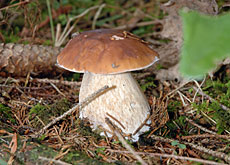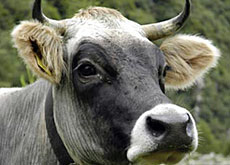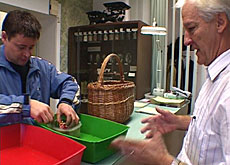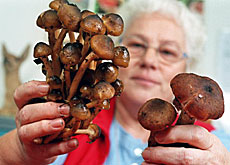Hundreds of mushroom species face extinction

Nearly a third of Switzerland’s mushroom species are under threat, either from pollution or from agriculture and building projects.
The Federal Environment Office has published the first-ever red list detailing the 937 known species facing possible extinction in the country.
There are approximately 5,000 species of mushrooms in Switzerland that are visible to the human eye.
“There is a high diversity of mushroom species thanks to the country’s geographical diversity and different climates,” said Beatrice Senn-Irlet of the Federal Institute for Forest, Snow and Landscape Research.
Around 3,000 of these species are well documented. Unfortunately, nearly a third of these might vanish altogether though.
According to the institute’s researchers, who put together the red list for the Environment Office, most of the threatened mushrooms belong to species that are highly dependent on their surroundings.
The slightest disturbance can modify the fungi’s relationship with its habitat, leading to its destruction in some cases. Habitat loss is the main threat for some mushroom species say the list’s authors.
Changes in agricultural practices, the growth of built-up areas and air pollution can lead to the destruction of some types of fungi, particularly in marsh or pasture zones.
Forest mushrooms are less endangered, thanks to more sustainable forestry practices implemented a century ago. But the researchers say there is not enough dead wood lying around on the ground to guarantee fungi development and that atmospheric contaminants are also having an effect.
The situation of Swiss mushroom species is not yet desperate. Switzerland’s fungi are in a similar state to those of Sweden, but fare better than those of the Netherlands where two thirds of documented species are threatened.
Mushroom hunting
Good news for mushroom lovers is that picking edible fungi is not being blamed for the disappearance of species. According to Senn-Irlet, there are around 200 edible varieties, none of which appear on the endangered list.
The only danger for mushroom survival seems to be if too many people walk in a zone where fungi are found, compacting the earth where they grow. The Environment Office is recommending that restrictions on mushroom picking be maintained and that zones where species are threatened be protected.
As mushrooming season begins, police sent out a strong reminder about picking restrictions. Three Italians were caught with 23 kilograms of penny bun mushrooms in eastern canton Graubünden last week, well above the legal limit of two kilograms per person.
The many Swiss mushroom pickers are also being warned to take care with what they collect. If they are unsure what they have in their basket, the association of national mushroom controllers is urging them to have their bounty checked to avoid too many cases of food poisoning.
There are around 150 species of poisonous mushrooms in Switzerland.
swissinfo with agencies
Red listed:
Threatened with extinction: Pink Waxcap (Hygrocybe calyptriformis)
Vulnerable: Caesar’s Mushroom (Amanita caesarea)
Vulnerable and protected: Laricifomes officinalis
There are around 200 species of large edible mushrooms in Switzerland and 150 which are poisonous.
The Swiss are huge fans of mushroom-picking. In canton Zurich around 10 tons of wild mushrooms are collected every year.
In 2006 the Swiss Toxicological Information Centre in Zurich answered 456 questions about poisonous mushrooms.
But there have only been a few cases of Swiss people dying after eating poisonous mushrooms: one case in 1996, 2001, 2002 and 2005.
There are around 800 mushroom inspection offices throughout Switzerland.
The Federal Environment Office’s red list is based on the criteria established by the World Conservation Union (IUCN) for its Red List of Threatened Species
The IUCN’s list provides taxonomic, conservation status and distribution information.
This system is designed to determine the relative risk of extinction, and the main purpose of a Red List is to catalogue and highlight those organisms or groups of organisms (taxa) that are facing a higher risk of global extinction.

In compliance with the JTI standards
More: SWI swissinfo.ch certified by the Journalism Trust Initiative



You can find an overview of ongoing debates with our journalists here. Please join us!
If you want to start a conversation about a topic raised in this article or want to report factual errors, email us at english@swissinfo.ch.